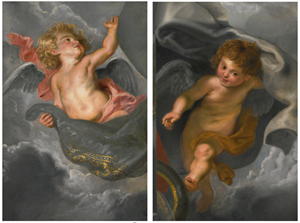
Sir Peter Paul Rubens and Workshop. SIEGEN 1577-1640 ANTWERP. PUTTI HOLDING ALOFT DRAPERIES.
In 1711, the church council of Notre-Dame de Finistère alighted upon The Virgin Immaculate as a suitable source of capital with which to finance the rebuilding of the church (undertaken from 1713-30). The painting was consequently sold to an Antwerp dealer, François Nuijs, and subsequently passed to one Wachters [or Wuchters] who, at some point before 1762, ordered the canvas to be cut into sections and proceeded to sell them off individually. The Virgin and Child fragment was purchased for the Schloss Sanssouci, Potsdam, in the nineteenth century, where it remained until its regrettable destruction in 1945.3 The globe is now in a private collection, Oxford.4
Meanwhile, the two putti were united to form a new, single composition, shown in flight around a garland of fruit.5 They remained in this arrangement until the early twentieth century when, in the collection of Dr Hans Wendland, the painting was cleaned, the garland removed and a piece of flowing drapery was added instead.6 It was not until the putti were acquired by Gaston Dulière that they were separated and given on long-term loan to the Rubenshuis. In 2010 the paintings were cleaned and restored, removing all the overpaint and finally revealing the pair as the dynamic, whimsical cherubs from the dismembered altarpiece.

Jaffé dates the original painting to 1626–28, shortly before Rubens left for Madrid. It is undoubtedly related to the version of the subject the artist painted in 1628 for the Marqués de Leganés when he reached Spain (Prado Museum, Madrid).7 Several authors, including Gustav Glück, rejected the putti when they were still combined in one composition and extensively overpainted. Since their separation, however, scholars have unanimously accepted the works as containing the hand of the master. The pentimento visible in the right leg and foot of the dark-haired cherub is testament to this. Most recently Arnout Balis of the Rubenianum, Antwerp, to whom we are grateful, has inspected the paintings first-hand and endorsed an attribution to Rubens and his workshop.
More information is here.

ArtDependence Magazine is an international magazine covering all spheres of contemporary art, as well as modern and classical art.
ArtDependence features the latest art news, highlighting interviews with today’s most influential artists, galleries, curators, collectors, fair directors and individuals at the axis of the arts.
The magazine also covers series of articles and reviews on critical art events, new publications and other foremost happenings in the art world.
If you would like to submit events or editorial content to ArtDependence Magazine, please feel free to reach the magazine via the contact page.